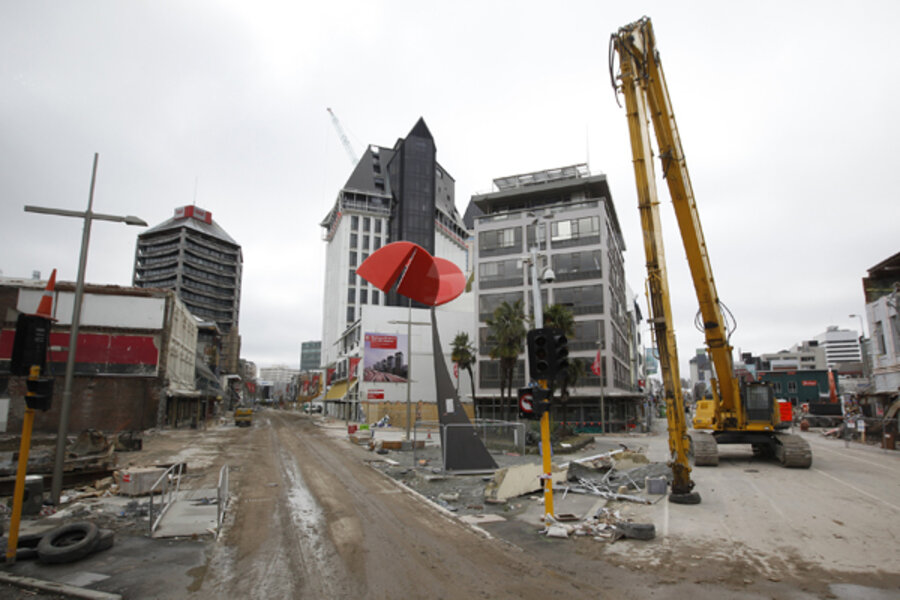Six months after New Zealand quake, Christchurch's ability to rebuild in doubt
Loading...
| Christchurch, New Zealand
When a strong aftershock struck the New Zealand city of Christchurch one night last week, Leanne Curtis awoke with a fright. She could not go back to sleep, and nor could her 8-year-old son, Louie. In fact, the next day, few children showed up at school.
The South Island city, which was devastated by a 6.3-magnitude earthquake in February, is a jittery place. More than 4,000 aftershocks have rattled it since that quake killed 181 people and destroyed tens of thousands of homes as well as much of the city center. The total cost of recovery is estimated at $12.5 billion.
“You can never relax,” says Ms. Curtis. “Everyone is on edge, and the aftershocks play with your head.”
New Zealand’s second-most populated city and a popular tourist destination has lived through three big quakes in the past year. Its inhabitants have just marked the anniversary of the first, which caused widespread damage but claimed no lives last September. Then came the deadly temblor six months ago, which was one of the most destructive in the country's history. And in mid-June a third quake toppled more buildings, further panicking residents.
The frequent aftershocks are hindering Christchurch’s recovery, with locals wondering whether to stay or go and businesses nervous about reinvesting. “It has slowed things down, because it makes people more cautious,” says Roger Sutton, chief executive of the Canterbury Earthquake Recovery Authority, a government agency overseeing the reconstruction effort.
That effort is still in its infancy. So comprehensive was the destruction in the city center that it will take another year to demolish about 200 collapsed or unsafe buildings, according to Mr. Sutton. The center remains entirely cordoned off, with floral tributes to the dead pinned to the metal fence that surrounds it.
Last month, Canterbury City Council – which covers Christchurch and the surrounding area – released a widely praised plan for a new, lower-rise, greener city. Some 9,700 homes, which previously faced possible demolition, have been cleared as safe for repair and reconstruction. But the city’s mayor, Bob Parker, says it will take a long time for wounds to heal. “I don’t believe that there’s anybody who doesn’t carry with them some trauma from these events,” he says.
A Royal Commission is examining why so many buildings collapsed, despite the area being known to be seismically active. Two-thirds of the people who died were in one building, which housed the local television channel, Canterbury TV, as well as other offices. The four-story building collapsed. No one inside survived.
Liquefied by the earthquakes
Among those hoping for answers is Maan Alkaisi, whose wife, Maysoon Abbas, was a doctor working in a clinic in the CTV block. The Iraqi-born couple emigrated to Christchurch 17 years ago.
Mrs. Abbas had complained that the building was shaky. “Maysoon’s death was like a bullet to my heart and a bullet to my head,” says Mr. Alkaisi. “I want to know why she went to work and never came back.”
Even among those who did not lose family or friends, the mood is gloomy. The recovery authority recently divided the city into zones. Ten thousand households in the “red zone” will have to move, because their land – liquefied by the earthquakes – is no longer stable. The government will buy their homes from them, but many are reluctant to leave.
To stay or go?
Sue Holmes lives in one of the worst affected neighborhoods, near the River Avon. Only six families, out of 55, remain in her potholed, buckled street. She is waiting for her insurance company to pay out; until then, she has no idea what else she can afford. Land prices have risen steeply because of demand.
Like many locals, Mrs. Holmes says she worries about another big quake. Scientists estimate there is a 1 in 4 chance of that happening in the next 12 months. “I don’t think I’ve had a decent night’s sleep for nearly a year,” Holmes says.
She and her husband have made preparations in case of an emergency in the middle of the night. “We’ve got torches [flashlights] all around the house, and we keep our shoes by the bed. We’ve timed ourselves, and we can grab the dogs and be dressed and out of here in less than a minute.”
City authorities are playing down reports of an exodus from the city, which has a population of 400,000. But many people are considering moving, Curtis puts it this way: “Do you stay and keep wondering if there’ll be another big one, or do you go?”





